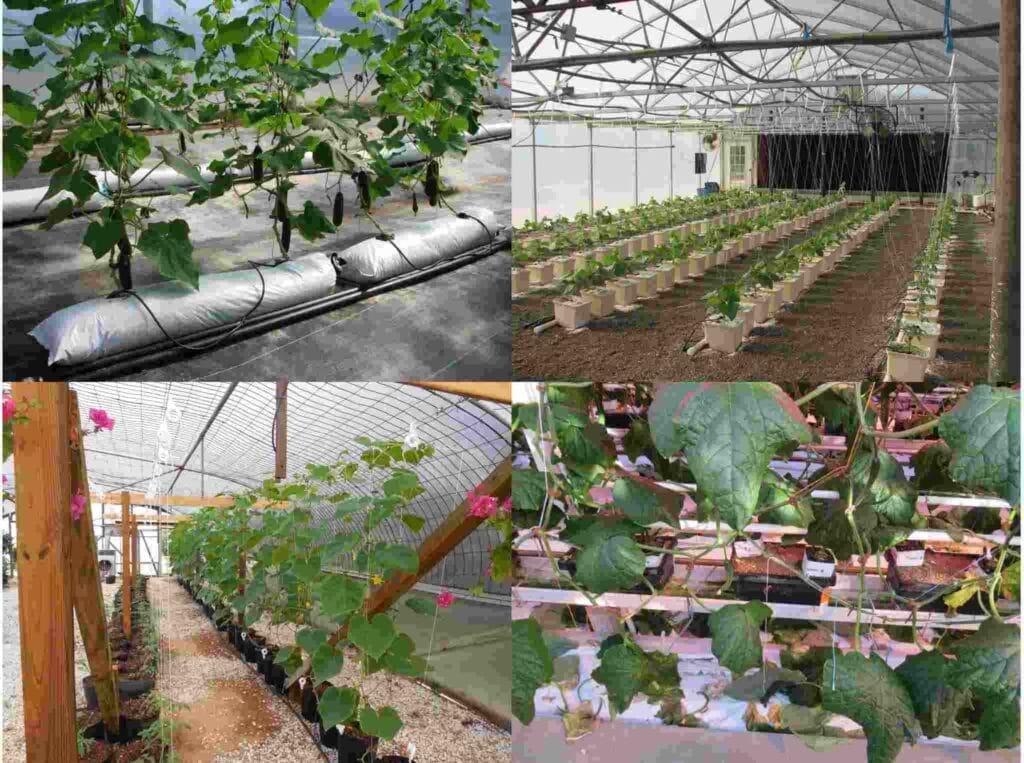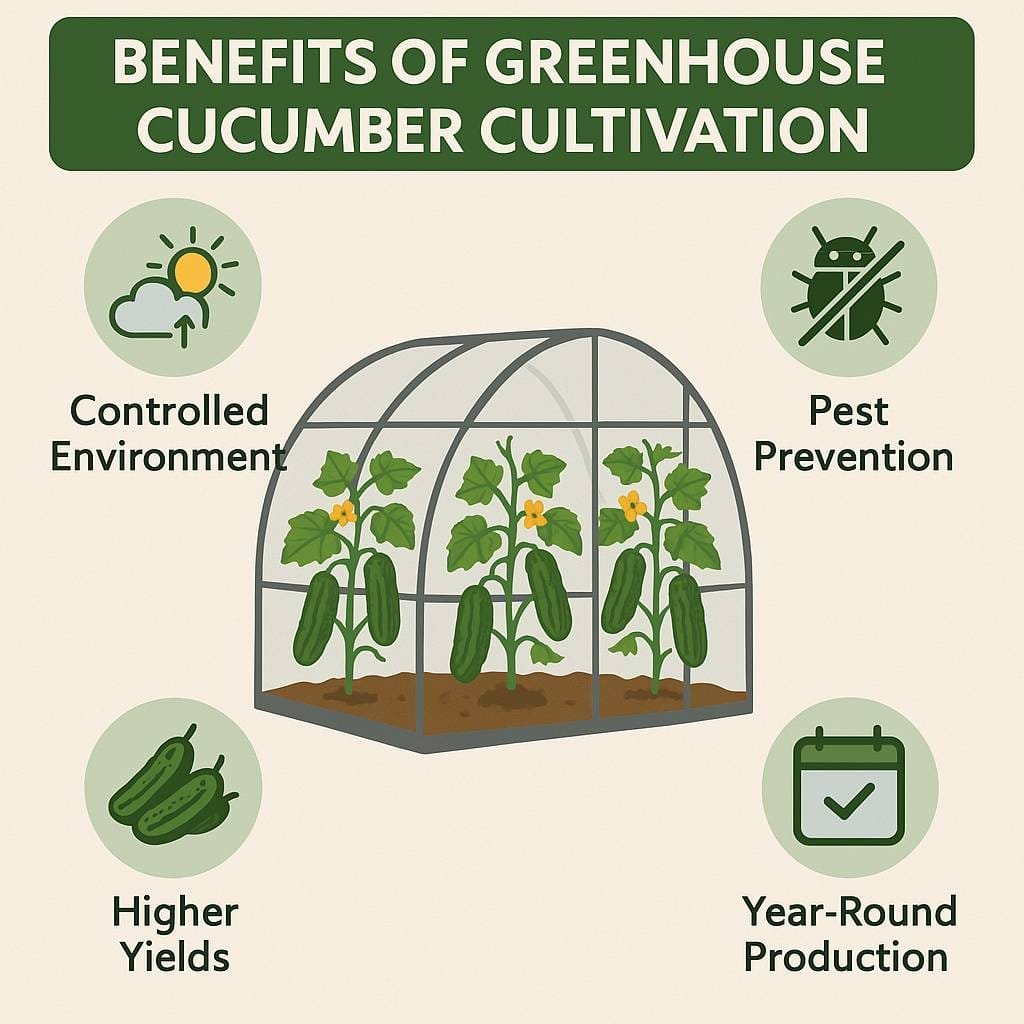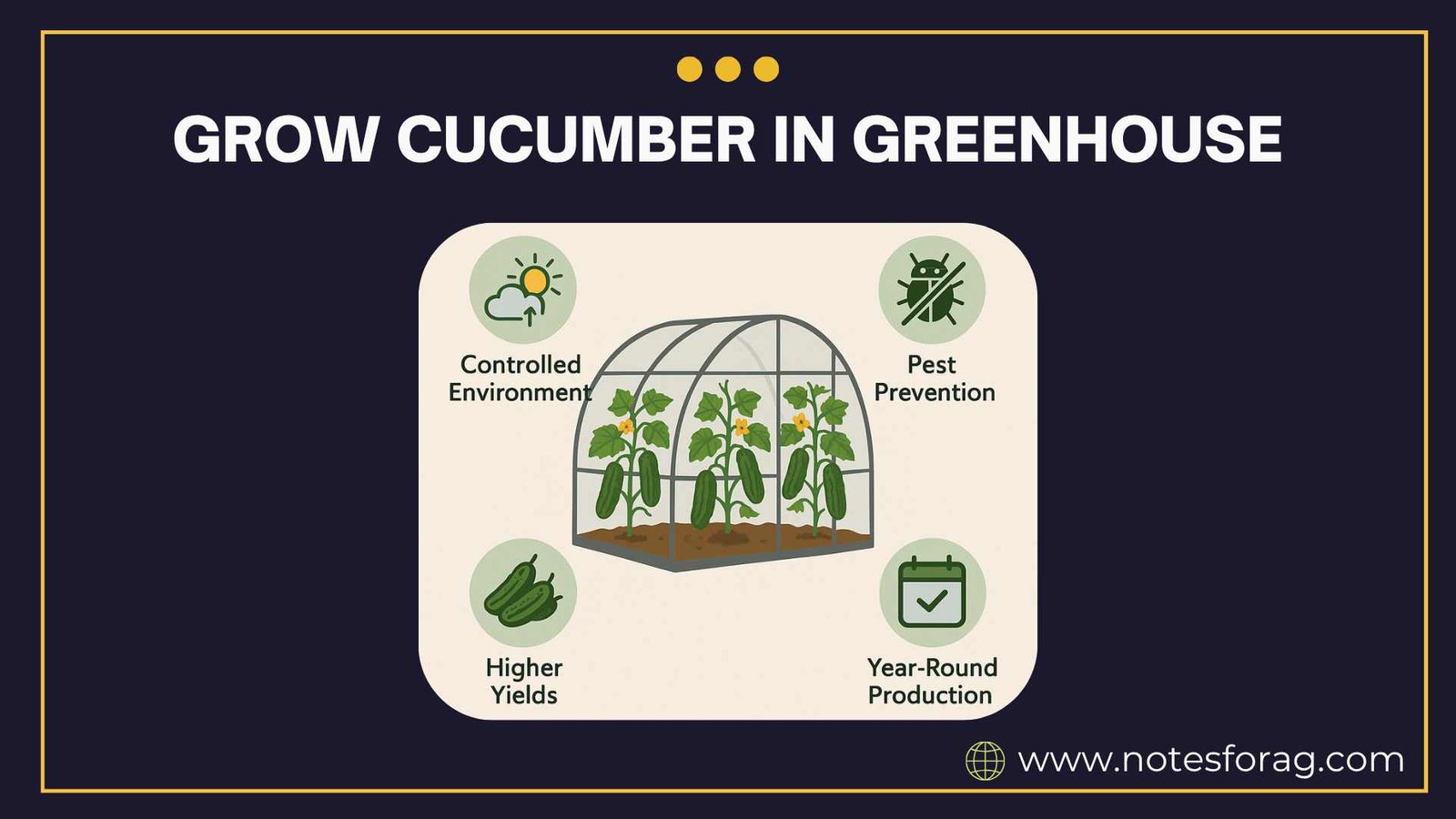Introduction
Cucumbers are among the most widely cultivated vegetables in greenhouse settings due to their high market demand, quick growth, and prolific yield. Greenhouse cultivation of cucumbers allows for controlled environmental conditions, which leads to healthier plants, fewer pest issues, and year-round production. Whether grown for fresh markets or processing, mastering cucumber cultivation in a greenhouse can be profitable and sustainable. This comprehensive guide explores every step of the process, from setup to harvest, using clear, practical methods suited for beginners and experienced growers alike.

Summary of Greenhouse
- Greenhouse-grown cucumbers thrive in controlled conditions, with optimal temperatures and high-value varieties ensuring productivity.
- Vertical trellising, drip irrigation, and pruning allow for efficient space use and healthier, high-yielding plants.
- Year-round yields are secured through proactive pest management, consistent harvesting, and proper post-harvest handling.
Table of Contents
Benefits of Greenhouse Cucumber Cultivation

Growing cucumbers in a greenhouse offers numerous advantages. It protects crops from adverse weather, reduces pest and disease pressure, and allows precise control over temperature, humidity, irrigation, and nutrient delivery. This results in higher yields and better-quality fruit. Additionally, greenhouse farming supports off-season production, leading to better prices and market stability.
Greenhouse Structure and Setup
Site Selection and Orientation
A well-drained, sunny location is ideal for placing the greenhouse. Proper orientation, usually east-west, maximizes sunlight exposure throughout the day. Windbreaks and fencing may be used to protect the structure.
Type of Greenhouse
Greenhouses can be naturally ventilated or climate-controlled (polyhouse, glasshouse, etc.). Choose a structure based on budget, climate, and scale of operation. High tunnels or low-cost polyhouses are suitable for small-scale farmers.
Materials and Equipment
Essential equipment includes drip irrigation systems, misting or fogging systems, heating or cooling systems (if required), shade nets, grow bags, and support trellises. The structure should allow 6-8 feet of vertical height for trellising cucumber vines.
Choosing the Right Cucumber Variety
Select varieties suitable for greenhouse conditions. These include parthenocarpic (self-pollinating) hybrids that produce high yields without insect pollination. Popular greenhouse cucumber varieties include:
- Poinsettia
- Boa
- Maverick
- Saniya
Parthenocarpic cucumbers tend to be seedless, uniform in size, and have a long shelf life ideal for commercial markets.
Soil and Growing Medium Preparation
Soil Requirements
Cucumbers prefer well-drained, fertile loamy soil with a pH between 6.0 and 6.8. Soil should be free of nematodes and soil-borne pathogens. Solarization or fumigation may be performed before planting to disinfect the growing medium.
Alternative Growing Media
For soilless cultivation, cocopeat, perlite, and vermiculite mixtures are commonly used. These media support root health, improve aeration, and minimize soil-borne diseases.
Sowing and Transplanting
Seed Germination

Seeds can be sown in trays or small pots filled with cocopeat. Maintain a temperature of 25–30°C and consistent moisture for optimal germination, which usually occurs in 4–7 days.
Transplanting Seedlings
Seedlings should be 2–3 weeks old with 3–4 true leaves before transplanting. Transplanting should occur during early morning or evening to avoid transplant shock. Spacing of 45–60 cm between plants and 90–120 cm between rows ensures optimal airflow and sunlight.
Plant Support and Trellising
Cucumber vines grow rapidly and require vertical support. Install trellis systems using wires, plastic nets, or strings tied to overhead supports. Train plants regularly by twisting vines around the support to encourage upward growth and prevent damage.
Irrigation and Fertilization
Drip Irrigation
Drip irrigation is ideal for greenhouse cucumbers. It provides uniform water delivery, conserves water, and reduces fungal disease risk. Watering frequency depends on temperature and growth stage.
Fertilization Schedule
Apply balanced NPK (Nitrogen-Phosphorus-Potassium) fertilizers with micronutrients. A recommended schedule:
- Initial stage: High phosphorus for root development
- Vegetative stage: Increased nitrogen
- Flowering/Fruiting stage: More potassium to enhance fruit size and taste
Foliar feeding with micronutrients like calcium, magnesium, and boron may also be done weekly.
Pruning and Training
Pruning Techniques
Remove side shoots up to the fifth node to encourage strong vertical growth. Maintain 1–2 stems per plant and remove yellow or diseased leaves.
Pollination
For parthenocarpic cucumbers, pollination is not required. For others, manual pollination or introduction of bees may be necessary.
Pest and Disease Management
Common Pests
- Aphids: Sap-sucking pests that distort leaves and transmit viruses
- Whiteflies: Cause leaf curling and sooty mold
- Spider mites: Lead to stippling and yellowing of leaves
- Thrips: Feed on tender leaves and flowers
Use sticky traps, insect-proof nets, and biopesticides like neem oil or Beauveria bassiana.
Common Diseases
- Powdery mildew: White fungal patches on leaves
- Downy mildew: Yellow spots and purple growth under leaves
- Fusarium wilt: Causes leaf wilting and plant death
Prevent diseases through crop rotation, proper spacing, and maintaining humidity below 80%. Fungicides may be applied as per recommendations.
Harvesting and Post-Harvest Handling
Harvesting Stage
Cucumbers should be harvested when they are uniformly green, firm, and about 6–9 inches long. Harvest regularly (every 2–3 days) to promote continued fruiting.
Post-Harvest Management
Handle fruits gently to prevent bruising. Store at 10–12°C with 85–90% relative humidity for prolonged shelf life. Pack in ventilated crates or cartons for market transport.
Marketing and Economics
Cucumbers grown in greenhouses often fetch premium prices due to their uniformity and off-season availability. Contract farming, local markets, supermarkets, and online delivery platforms can be viable sales channels. With proper planning and management, greenhouse cucumber farming can be profitable within one cropping cycle.
Conclusion
Growing cucumbers in a greenhouse offers a dynamic solution for gardeners aiming for high yields, year-round production, and consistent fruit quality. With the right setup be it a polyhouse, glasshouse, or simple tunnel growers can regulate temperature, humidity, and irrigation to meet cucumbers’ ideal conditions of 75–85°F during the day and 60–70°F at night.
Choosing parthenocarpic or gynoecious varieties like ‘Poinsettia’, ‘Diva’, and ‘Zozula’ eliminates the need for insect pollination and ensures reliable fruit set in enclosed spaces.
By starting seeds indoors, transplanting healthy seedlings, and using vertical trellising, greenhouse cucumber plants grow vigorously while using space efficiently and reducing disease risk. Successful cultivation also relies on drip irrigation under well-drained, neutral-pH soil, along with balanced fertilization and regular pruning to support optimal plant health and fruit development.
Pest and disease management is another critical aspect common issues like powdery mildew, aphids, and whiteflies can be managed with neem oil, biological controls, and environmental techniques like maintaining humidity below 70% and ensuring good airflow. Frequent harvest every 2–3 days, gentle handling, and storing at 10–12°C extend fruit quality post-harvest.
In essence, greenhouse cucumber production is a professional yet accessible practice that combines careful variety selection, environmental control, and hands-on management. The pay-off is a steady supply of crisp, uniform cucumbers that command premium prices, especially during off-seasons. Whether you’re a hobbyist transforming a home greenhouse or a commercial grower, the principles remain the same: optimize the growing environment, support plant structure, and manage health proactively, and your greenhouse will yield a rewarding and flavorful harvest all year long.
Frequently Asked Questions (FAQs)
What temperature is best for growing cucumbers in a greenhouse?
Cucumbers grow best at 75–85°F during the day and 60–70°F at night, which promotes healthy plant growth and high-quality fruit.
Do greenhouse cucumbers require pollination?
Most greenhouse cucumbers are parthenocarpic, producing fruit without pollination, but varieties that are not require hand pollination or natural pollinators.
How often should greenhouse cucumbers be harvested?
Harvest every 2–3 days once cucumbers are firm and about 6–9 inches long to encourage continuous fruiting and maintain quality.
Related Articles

